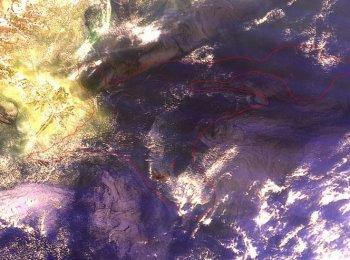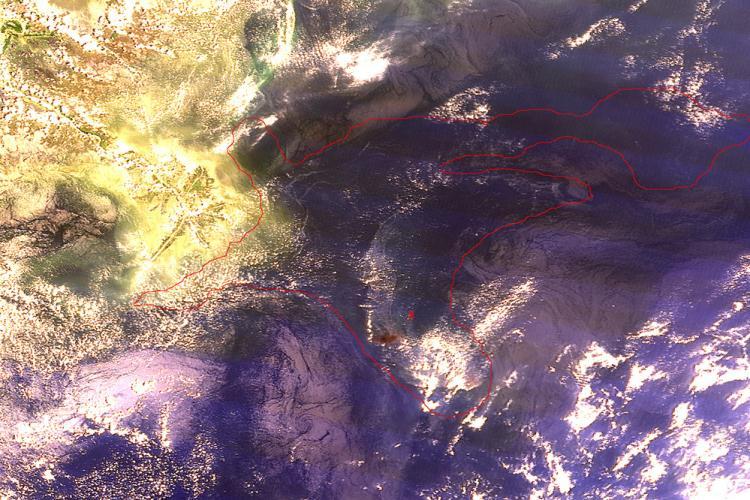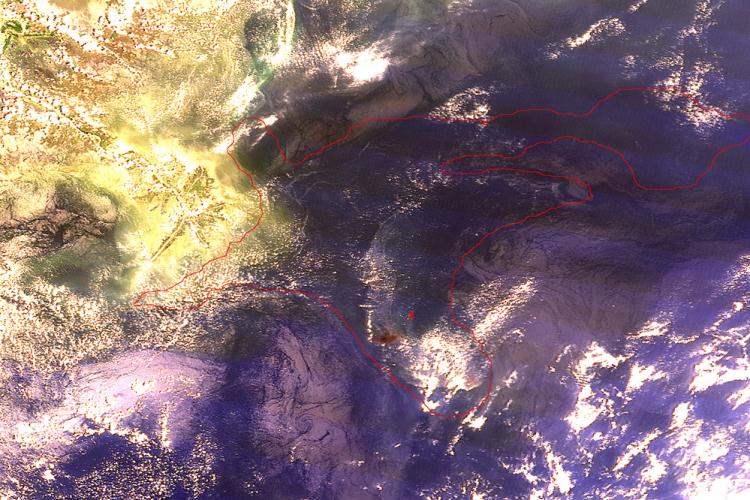The Gulf of Mexico oil spill following the sinking of the Deepwater Horizon oil rig has resulted in an ecological disaster, threatening the Gulf fisheries and the economy of the coastal States as well. The Epoch Times’ Chang Lee got some answers about the potential impact of the oil spill in an interview with two oceanography experts.
Dr. Chuanmin Hu is an Associate Professor of Optical Oceanography at the College of Marine Science, University of South Florida and Dr. Edward S. Van Vleet is a professor of Chemical Oceanography and Director of Academic Affairs, also at the University of South Florida.
Epoch Times (ET): Please make a rough prediction on the oil spill spreading and flowing in the coming weeks. BP is trying to block the leak; that will take at least a week.
Professor Hu (HU): The oil spreading has been quite steady in the past week and appears to remain so in the next week. Currently it is about 4000—5000 square kilometers, about 3 times of the size of Lake Okeechobee. At the time of this writing we can still see the leaking from satellite imagery. Wind forecast suggest weak, southerly wind in the next few days, so the oil will likely stay there but spread slowly towards the north. Some of the oil filaments may have already been entrained in the Loop Current (LC) shed eddies (not the LC itself), it is unknown how much that could be. Once entrained in the LC, it could be carried to the Florida Keys within 1 to 5 weeks, depending on the LC eddies. In the past, we have seen Mississippi River water carried by the LC to the Florida Straits and to Florida’s east coast and to Georgia. It may happen again, but the exact oil volume is unknown.
ET: I heard that Florida’s east coast will probably be at even higher risk to be hit by the oil spill than its west coast does. Most likely, which part of Florida’s coast will possibly be hit by the oil?
HU: Yes—once the oil gets into the LC it will reach the Florida Keys and east coast quickly (within weeks). The beaches that will be most affected will include those in the FL keys and Miami. The west coast from Tampa to Naples are relatively safe. However, in the long run, if the oil reaches the Florida Panhandle, it may eventually get to the west coast.
ET: What is the possible impact of oil spill on FL ecosystems, plants, animals?
HU: In short—disaster. Many animals and plants will be dead under heavy oil pollution - there have been historical cases. Oil volume and flux are two keys. In the western Gulf of Mexico, there are at least
hundreds of natural oil seeps that may collectively seep the same amount of oil to the ocean as this event, but that oil is highly diluted, quickly degraded, and the animals/plants living around them
have adapted to this environment. This case is different.
ET: What kind of fate the oil itself will have, under so hot summer, strong sunlight?
HU: Oil gets oxidized, evaporated, and weathered. It may mix with water and drop to the shallow bottom—that’s when disasters happen to the benthic ecosystem.
ET: Please make a rough prediction on the oil spill spreading and flowing within the following weeks. BP is trying to block the leak that will take at least a week. The effect of Loop Current, on wind and on oil.
Dr. Edward S. Van Vleet (VAN VLEET): This is not my area of expertise, so my knowledge in this area is limited. One of the main problems is that it is still too early to predict exactly what is going to happen to the oil being released at the blowout sight. Changes in weather and wind patterns over the next 48 hours should allow a better indication of what will happen to the oil. There appear to be three or four scenarios for what could happen. First, if the wind conditions persist from the south, and the oil does not become entrained in the Gulf Loop Current, then the oil will most likely wash ashore along the Florida Panhandle, as well as the coast of Mississippi and Alabama. This could occur within the next 24-72 hours.
If the wind patterns shift to having the winds come out of the north, then the oil could become entrained in the Gulf Loop Current, which will then carry the oil southeastward about 100 miles from the west Florida coastline. The Loop Current then turns east and transports water (and potentially the oil) out of the Gulf of Mexico between the Florida Keys and Cuba, and then it travels northward along the east coast of Florida. These currents are much closer to the coastline in this area. As the water travels along the Keys and Florida’s east coast, small eddies can break off of the Loop Current and transport the oil toward the coastline where it will wash ashore. If the oil is transported by the Gulf Loop Current, the most likely area where it would wash ashore in Florida would be between Key West and Ft. Pierce. According to Dr. Frank Muller-Karger from the University of South Florida, this would take about 7-10 days from the time it is first entrained in the Loop Current.
A third scenario according to Dr. Muller-Karger is for the spilled oil to be pushed by winds and slowly drift along the Florida coastline from the blowout site through the Big Bend area, and then southward along the west coast of Florida. In this way, the oil could eventually impact the environment around the Tampa Bay region. This transport route could take several weeks. One final scenario for the fate of the oil if it becomes trapped in the Loop Current, and then travels southward in the Gulf, would be if a persistent and fairly strong wind from the west were to blow across the shelf, it could push oil from the Loop Current eastward onto the beaches of west Florida. According to Dr. Muller-Karger, these winds would need to persistently blow for a period of at least a week. Which of these scenarios occurs will depend upon how the wind and weather patterns shift over the next few days and weeks.
ET: I heard that FL’ east coast will be at even higher risk to be hit by the oil spill than its west coast does. Most likely, which part of Florida coast will possibly be hit by the oil?
VAN VLEET: As mentioned, this is certainly true if the oil gets entrained in the Gulf Loop Current. If this is the case, the most likely area for the oil to wash ashore would be between Key West and the central part of Florida’s east coast, perhaps around the Ft. Pierce area.
ET: What is the possible impact of oil spill on Florida ecosystems, plants, animals?
VAN VLEET: Florida’s coastal ecosystems are particularly vulnerable to oil. Florida’s seagrass beds, mangroves, and coral reefs provide shelter, habitat and breeding grounds for fish, shellfish, bivalves and many other species. If the oil impacts these habitats, not only will the seagrass, mangroves or coral reefs be impacted, but all of the other species that reside or depend on these ecosystems will also be impacted. According to research previously carried out on an oil spill in Panama, it was predicted that although seagrass beds may recover in a period of 1-2 years, mangrove ecosystems may take up to 50 years to recover, and coral reefs may take as long as 100 years or more to fully recover. Marine birds and sea turtles are two other types of marine species that can be heavily impacted by oil spills.
ET: What and how can people do to lessen the damages from the disaster?
VAN VLEET: This is very difficult. Other than volunteering to work with beach clean-up, bird or turtle rehabilitation, or similar responses, there is not much we can do to stop the spill. BP, the Coast Guard.
ET: What kind of fate the oil itself will have, under so hot summer, strong sunlight?
VAN VLEET: Some photodegradation will occur to oil exposed directly to sunlight, however the extent of this is fairly small. Even after the oil washes ashore, photo degradation will only occur on the outer surface of the oil. Microbial degradation will also play a role in the degradation of the oil over a period of weeks or months, but again bacteria are limited in the extent to which they can degrade the oil.
The interview was conducted on May 5 by Epoch Times reporter Chang Lee.
Dr. Chuanmin Hu is an Associate Professor of Optical Oceanography at the College of Marine Science, University of South Florida and Dr. Edward S. Van Vleet is a professor of Chemical Oceanography and Director of Academic Affairs, also at the University of South Florida.
Epoch Times (ET): Please make a rough prediction on the oil spill spreading and flowing in the coming weeks. BP is trying to block the leak; that will take at least a week.
Professor Hu (HU): The oil spreading has been quite steady in the past week and appears to remain so in the next week. Currently it is about 4000—5000 square kilometers, about 3 times of the size of Lake Okeechobee. At the time of this writing we can still see the leaking from satellite imagery. Wind forecast suggest weak, southerly wind in the next few days, so the oil will likely stay there but spread slowly towards the north. Some of the oil filaments may have already been entrained in the Loop Current (LC) shed eddies (not the LC itself), it is unknown how much that could be. Once entrained in the LC, it could be carried to the Florida Keys within 1 to 5 weeks, depending on the LC eddies. In the past, we have seen Mississippi River water carried by the LC to the Florida Straits and to Florida’s east coast and to Georgia. It may happen again, but the exact oil volume is unknown.
ET: I heard that Florida’s east coast will probably be at even higher risk to be hit by the oil spill than its west coast does. Most likely, which part of Florida’s coast will possibly be hit by the oil?
HU: Yes—once the oil gets into the LC it will reach the Florida Keys and east coast quickly (within weeks). The beaches that will be most affected will include those in the FL keys and Miami. The west coast from Tampa to Naples are relatively safe. However, in the long run, if the oil reaches the Florida Panhandle, it may eventually get to the west coast.
ET: What is the possible impact of oil spill on FL ecosystems, plants, animals?
HU: In short—disaster. Many animals and plants will be dead under heavy oil pollution - there have been historical cases. Oil volume and flux are two keys. In the western Gulf of Mexico, there are at least
hundreds of natural oil seeps that may collectively seep the same amount of oil to the ocean as this event, but that oil is highly diluted, quickly degraded, and the animals/plants living around them
have adapted to this environment. This case is different.
ET: What kind of fate the oil itself will have, under so hot summer, strong sunlight?
HU: Oil gets oxidized, evaporated, and weathered. It may mix with water and drop to the shallow bottom—that’s when disasters happen to the benthic ecosystem.
ET: Please make a rough prediction on the oil spill spreading and flowing within the following weeks. BP is trying to block the leak that will take at least a week. The effect of Loop Current, on wind and on oil.
Dr. Edward S. Van Vleet (VAN VLEET): This is not my area of expertise, so my knowledge in this area is limited. One of the main problems is that it is still too early to predict exactly what is going to happen to the oil being released at the blowout sight. Changes in weather and wind patterns over the next 48 hours should allow a better indication of what will happen to the oil. There appear to be three or four scenarios for what could happen. First, if the wind conditions persist from the south, and the oil does not become entrained in the Gulf Loop Current, then the oil will most likely wash ashore along the Florida Panhandle, as well as the coast of Mississippi and Alabama. This could occur within the next 24-72 hours.
If the wind patterns shift to having the winds come out of the north, then the oil could become entrained in the Gulf Loop Current, which will then carry the oil southeastward about 100 miles from the west Florida coastline. The Loop Current then turns east and transports water (and potentially the oil) out of the Gulf of Mexico between the Florida Keys and Cuba, and then it travels northward along the east coast of Florida. These currents are much closer to the coastline in this area. As the water travels along the Keys and Florida’s east coast, small eddies can break off of the Loop Current and transport the oil toward the coastline where it will wash ashore. If the oil is transported by the Gulf Loop Current, the most likely area where it would wash ashore in Florida would be between Key West and Ft. Pierce. According to Dr. Frank Muller-Karger from the University of South Florida, this would take about 7-10 days from the time it is first entrained in the Loop Current.
A third scenario according to Dr. Muller-Karger is for the spilled oil to be pushed by winds and slowly drift along the Florida coastline from the blowout site through the Big Bend area, and then southward along the west coast of Florida. In this way, the oil could eventually impact the environment around the Tampa Bay region. This transport route could take several weeks. One final scenario for the fate of the oil if it becomes trapped in the Loop Current, and then travels southward in the Gulf, would be if a persistent and fairly strong wind from the west were to blow across the shelf, it could push oil from the Loop Current eastward onto the beaches of west Florida. According to Dr. Muller-Karger, these winds would need to persistently blow for a period of at least a week. Which of these scenarios occurs will depend upon how the wind and weather patterns shift over the next few days and weeks.
ET: I heard that FL’ east coast will be at even higher risk to be hit by the oil spill than its west coast does. Most likely, which part of Florida coast will possibly be hit by the oil?
VAN VLEET: As mentioned, this is certainly true if the oil gets entrained in the Gulf Loop Current. If this is the case, the most likely area for the oil to wash ashore would be between Key West and the central part of Florida’s east coast, perhaps around the Ft. Pierce area.
ET: What is the possible impact of oil spill on Florida ecosystems, plants, animals?
VAN VLEET: Florida’s coastal ecosystems are particularly vulnerable to oil. Florida’s seagrass beds, mangroves, and coral reefs provide shelter, habitat and breeding grounds for fish, shellfish, bivalves and many other species. If the oil impacts these habitats, not only will the seagrass, mangroves or coral reefs be impacted, but all of the other species that reside or depend on these ecosystems will also be impacted. According to research previously carried out on an oil spill in Panama, it was predicted that although seagrass beds may recover in a period of 1-2 years, mangrove ecosystems may take up to 50 years to recover, and coral reefs may take as long as 100 years or more to fully recover. Marine birds and sea turtles are two other types of marine species that can be heavily impacted by oil spills.
ET: What and how can people do to lessen the damages from the disaster?
VAN VLEET: This is very difficult. Other than volunteering to work with beach clean-up, bird or turtle rehabilitation, or similar responses, there is not much we can do to stop the spill. BP, the Coast Guard.
ET: What kind of fate the oil itself will have, under so hot summer, strong sunlight?
VAN VLEET: Some photodegradation will occur to oil exposed directly to sunlight, however the extent of this is fairly small. Even after the oil washes ashore, photo degradation will only occur on the outer surface of the oil. Microbial degradation will also play a role in the degradation of the oil over a period of weeks or months, but again bacteria are limited in the extent to which they can degrade the oil.
The interview was conducted on May 5 by Epoch Times reporter Chang Lee.



Friends Read Free